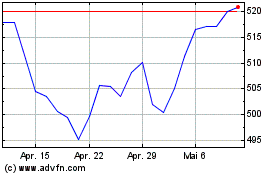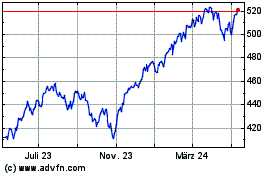SPY: The S&P 500 Index Likely to Remain Volatile in Q4 of 2023
02 Oktober 2023 - 11:23AM
Finscreener.org
The rally surrounding tech stocks
has driven the
S&P 500 index higher by 12.6% in the first nine months of
2023. Comparatively, the tech-heavy NASDAQ Composite index is up over 27% year-to-date.
However, in recent trading
sessions, Wall Street analysts and stock market investors remain
wary of a sluggish macro economy, lower consumer spending, higher
interest rates, and elevated inflation, dragging share prices of
companies across sectors significantly lower.
Let’s see why the S&P 500
and other equity indices might remain volatile in Q4 of
2023.
Consumer savings are on the decline
Citigroup (NYSE: C) CEO
Jane Fraser has noted a change in spending habits among
lower-income consumers as they attempt to stretch their diminishing
savings, revealing this insight during an interview with CNBC’s
Sara Eisen. Citigroup, America’s third-largest bank, has been
closely observing the financial behaviors of its credit cardholders
for early signs of financial strain.
Fraser highlighted emerging
issues among consumers with lower FICO scores, indicating that the
surplus savings accumulated during the pandemic are nearing
exhaustion. The shift in financial stability can be attributed to
the substantial financial assistance provided by the U.S.
government to households and businesses during the COVID-19 crisis.
This influx of funds contributed to the economy’s resilience,
defying many initial projections.
However, the ongoing series of
interest rate hikes by the Federal Reserve, the most vigorous in 40
years, has increased the cost of credit card debts, mortgages, and
auto loans. Consequently, incidents of late payments and defaults
are on the rise.
In discussing the broader
economic landscape with Fraser, other corporate executives have
echoed concerns beyond artificial intelligence and labor shortages.
They’ve shared observations of a softening demand, signaling
potential economic headwinds ahead.
Student loan to resume for 40 million
Americans
The moratorium on federal student
loan repayments, a relief that has been in place since the onset of
the pandemic, is set to conclude this Sunday. This change is set to
affect approximately 40 million Americans, who will now be obliged
to resume payments that have been on hold for over three
years.
The reintegration of this
financial obligation carries an air of unpredictability for
individual households and the broader economy. There is no
historical reference to gauge the potential impacts of such an
extensive pause in loan repayments. As the Biden administration
initiates the process of collecting over $1.7 trillion in federal
student loans, both retail sectors and financial institutions are
preparing for potential economic turbulence.
Jefferies, a prominent financial
services company, has expressed concerns regarding the impending
risk to consumer spending due to the resumption of student loan
repayments. A recent survey conducted by the firm involving
approximately 600 student loan recipients showed that half of the
respondents harbored significant concerns about their ability to
cover all their expenses once loan payments recommence.
The survey also indicated
behavioral shifts in spending, with about 70% of borrowers
intending to delay significant purchases beginning in October.
Additionally, many individuals with student debt are expected to
reduce their clothing, travel, and dining expenditures.
The lift of the repayment freeze
introduces an element of financial strain and adaptation, the
effects of which on the broader economic landscape remain to be
fully realized.
Jobs market update
This week, investors will receive
new insights into the state of the labor market, beginning with the
August Job Openings and Labor Turnover Survey (JOLTS) release on
Tuesday.
Following that, on
Wednesday, ADP (NASDAQ:
ADP), a prominent payroll provider, will publish
its National Employment Report for September, offering a detailed
account of private sector payroll expansions.
These preliminary reports will
lead to the unveiling of the nonfarm payroll data for September on
Friday, providing a comprehensive overview of the employment
landscape.
Though still robust and nearing
historic peaks, the job market has started to feel the impacts of
the Federal Reserve’s rate hikes. While still strong, hiring is
showing signs of slowing, marking a testament to the enduring
strength and adaptability of the job market in the face of economic
adjustments.
SPDR S&P 500 (AMEX:SPY)
Historical Stock Chart
Von Okt 2024 bis Nov 2024

SPDR S&P 500 (AMEX:SPY)
Historical Stock Chart
Von Nov 2023 bis Nov 2024
